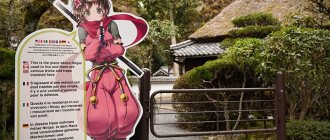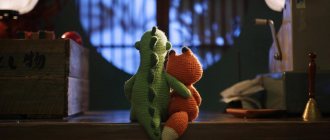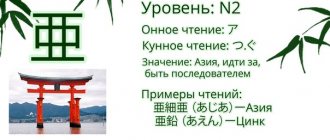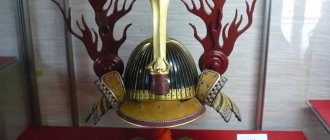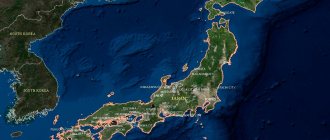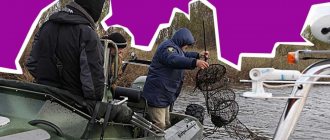29.04.2019
There were incredible legends about ninjas in medieval Japan. They said that a ninja warrior is capable of flying, breathing under water, becoming invisible, and in general these are not people, but creatures of demons.
The entire life of any medieval ninja was surrounded by legends. In fact, all fantastic stories about ninjas were born in the superstitious minds of uneducated medieval Japanese. Ninjas, in turn, maintained their supernatural reputation in every possible way, which gave them a huge advantage in battle.
The history of the appearance of ninjas in Japan
The first mentions of an art similar to ninjutsu can be found in ancient Indian treatises. It was from there, together with Buddhism, that this art was brought by the Yamabushi hermit monks. Mountain monks were a rather specific caste. They mastered weapons perfectly and were unsurpassed healers and sages. It was from them that young ninjas were trained, to whom the yamabushi passed on some of their fantastic knowledge for that time.
The history of ninjas begins around the 6th century, but the last professional ninja clans were destroyed in the 17th century. More than a thousand years of ninja history has left an indelible mark on Japanese history, although the secrets of the ninja (a small part of them) were revealed only at the end of the 20th century, by the last patriarch of ninjutsu, Masaaki Hatsumi.
Ninja clans were widely scattered throughout Japan, most often masquerading as an ordinary peasant village. Even neighboring villages did not know about ninjas, since they were outcasts, and every person in medieval Japan considered it his duty to destroy these “demons.” That is why all ninjas on missions used masks, and in a hopeless situation they were obliged to disfigure their faces beyond recognition so as not to betray the clan.
Tomo Sukesada
0
Tomo Sukesada was a jonin (ninja master) of Koga, as well as the head of the Tomo Ryu school tradition. In 1562, Tokugawa Ieyasu, working for Oda Nobunaga, destroyed the remnants of the Imagawa clan after their defeat at the Battle of Okehazama two years earlier. Representatives of the Imagawa clan, who did not want to surrender without a fight, under the command of General Imagawa named Udono Nagamochi, dug in at Kaminogou Castle, located in an exceptionally strategically favorable location, above a cliff. Taking the castle seemed quite difficult for Tokugawa Ieyasu, especially since the Imagawa had taken several members of his family hostage. Therefore, Ieyasu hired 80 ninja from the Koga school, led by Sukesada, to sneak into Imagawa's castle. Working alongside Hattori Hanzo, Sukesada and 80 Koga ninja led by him sneaked into the castle, set fire to the towers and killed the 200 garrison, including the general. This event is described in detail in the Mikawa Go Fudoki.
The harsh education of a ninja from birth
Despite the abundance of films about ninjas, where a stern hero learns all the intricacies over several years and crushes his enemies like straw, the best ninjas were those who were born into the clan.
A ninja master had to study throughout his life, so before becoming a ninja, children went through a rigorous school of training that began at birth. All children born into the clan were automatically considered ninjas. The cradle with the newborn was hung near the wall and constantly rocked so that it would hit it. The child subconsciously tried to group, and such a skill was fixed in him at the level of instinct.
Children under eight years of age were taught to endure any pain. Some stories about ninjas say that children were suspended by their hands from great heights, teaching them to overcome feelings of fear and developing endurance. After the age of eight, children began to be trained as real ninja warriors, until this age they had to be able to do the following:
- To endure any pain and take any blows without a groan;
- Read, write and know the secret alphabet, which was different in each ninja clan;
- Imitate the sounds of any animals and birds, which was often used to give signals;
- It's great to climb trees (some were even forced to live there for weeks);
- It is good to throw stones and any objects;
- To endure any bad weather without complaint (for which they were forced to sit in cold water for hours);
- It’s great to see in the dark (this was achieved through many days of training in dark caves and a special diet containing large amounts of vitamin A);
- Swim in water like a fish and be able to hold your breath for a long time under water. In addition, the ninja had to be able to conduct underwater combat both with weapons and with bare hands;
- Turning your joints in any direction (which had a significant effect with age, although ninjas rarely lived to old age).
In addition, children used military weapons as toys, and used any available objects as ninja weapons. By the age of eight, the child had such strength, endurance and flexibility that he could easily outshine any modern professional athlete. Trees, stones and rocks were used as sports equipment.
Training an adult warrior or how to become a ninja
Starting from the age of 15, young ninjas (whose fighting qualities already exceeded the training of a medieval warrior many times over) went to the mountains to learn the ancient art of monks - yamabushi. They served as the prototype for bearded elders in films about ninjas. Although from the history of the Yamabushi one can understand that they were real warriors who brutally dealt with their enemies.
Here, students studied basic psychological training skills, learned how to make medicines, poisons, and learned secret techniques of non-contact combat.
Ninjas knew the secret of disguise perfectly. Even very attentive warriors could not recognize the best actors. Today the ninja was a fat merchant, and tomorrow he was an exhausted beggar. Moreover, it was the role of a beggar tramp that required the ninja to completely get used to the role. The combat ninja looked like an old man dying of hunger. The best masters of transformation took poisons that made the body look weak and the face covered with wrinkles.
In general, the quality of transforming into a powerless person was quite widely used by medieval spies. In battle, the ninja often pretended to be overwhelmed by his opponent's superior fighting skills and fought with an air of doom. The enemy would lose his guard and begin to casually swing his weapon, after which he would receive a lightning strike from the “demoralized” ninja.
If the enemy did not succumb to such tricks, the ninja could pretend to be mortally wounded and fall to the ground in convulsions, spitting out blood. The enemy approached and immediately received a fatal blow.
Military armor
The shinobi's special advantage was mobility and speed, which is perhaps why they never wore full armor. During bloody battles, fighters protected their bodies with light chain mail. In rare cases, a protective kit was used, which included the following ninja armor:
- Chain shirt.
- Arm sleeves (from elbow to hands).
- A helmet that protected not only the head, but also the neck and chin area.
- Shield.
- The uwappari outer jacket was usually worn over the chain mail.
The lowest-ranking fighters were equipped with light tatami-gusoku armor, consisting of pieces of leather on which iron plates were sewn. Such uniforms protected the ninja only from the front.
It is very interesting how the warriors used tetsu no kame shields. They were held not only on the arm, but also thrown behind the back, threading the arms under the slings. When retreating, the ninja could calmly expose their back to the enemy, which was reliably covered by such a shield. The thickness of tetsu no kame was such that neither bullets nor arrows could penetrate it.
Another advantage of the ninja shield is its spherical shape. A warrior could lie down on the ground and, throwing his shield on his back, crawl to enemy positions. The bullets ricocheted off the iron sphere as if from tank armor. Climbing into a hole or grouping with his legs tucked under him, a fighter could turn into a kind of invulnerable living pillbox.
Physical capabilities of ninjas and their “supernatural” abilities
The average ninja could cover about a hundred kilometers a day, now this seems incredible, since even the best modern athlete is not capable of such feats. With their bare hands they broke bones and knocked down doors, and their dexterity was simply incredible. The ninja, who often used huge claws as weapons, spent part of his life on a tree, and during operations he wore a specific ninja mask, which turned him into a terrible demon. It was a rare resident of medieval Japan who dared to engage in combat with a demon that silently appeared behind him.
The magical abilities of the ninja are explained quite simply:
- The ability to become invisible is associated with the use of smoke bombs. The explosion of such a grenade was accompanied by a sheaf of sparks and a bright flash, which distracted attention, and a smoke veil, using which the ninja disappeared unnoticed;
- The ninja could escape even without a smoke bomb if there was water nearby. Having dived there unnoticed, a warrior could breathe for hours through a reed tube or a hollow sword sheath;
- Ninjas knew how to run on water only because they prepared each operation in advance. Special flat stones were placed under the water, the location of which the ninja remembered and then easily jumped on them, creating the illusion of walking on water;
- Legends said that no shackles could hold a werewolf-ninja, as he would still break free. This technology for releasing ropes was known not only to ninjas. It lies in the fact that when tying you need to tense the muscles as much as possible, then after they relax the bonds will not be too tight. The ninja's flexibility helped him in his release;
- Ninjas owe their ability to walk on walls and ceilings to training in the forest, when they jumped on trees and the use of special brackets with which they could secure themselves on the ceiling. A trained ninja could hang motionless on the ceiling for days, waiting for a victim.
The ability to endure pain greatly helped the ninja when falling into a bear trap. If time allowed, he could calmly free his leg and, having stopped the bleeding, escape. With a lack of time, the ninja cut off their leg and, jumping on the surviving one, tried to escape.
Use of poisons
To achieve their goals, the ruthless killers did not disdain anything. For example, they widely used various toxic substances to kill the enemy.
Ninja poisons were divided into 3 categories:
- Instant action.
- Acting over a short period of time (lycoris, arsenic).
- With delayed action or slow-acting. These poisons were usually made from a special type of green tea or animal entrails.
An interesting method of poisoning was often used by hired killers: drops of poison rolled into the ear or mouth of a sleeping victim along a thread hanging from above. Each clan had its own secrets for preparing poison.
Ninja Clothing and Disguise
We all know that ninjas wore a black suit, and the “good” ninja wore a white suit. In fact, this myth was very far from reality. Most often, ninjas disguised themselves as traders, travelers or beggars, because a person in black clothes will be visible everywhere, since the completely black color is very rare in nature. The famous ninja night uniform was dark brown or dark blue. For battle there was a red uniform that hid wounds and blood. The suit had many pockets for various devices and hidden weapons.
The costume was always accompanied by a ninja mask, which was made from a two-meter piece of fabric. It was impregnated with a special composition that could serve to stop bleeding and disinfect wounds. In addition, drinking water could be filtered through the mask and used as a rope.
Momochi Sandayu
0
Ishikawa Goemon from the previous point was supposedly Momochi Sandayu's student before he became a nukenin. Momochi Sandayu was one of the founders of Iga Ryu Ninjutsu, and is considered one of the three greatest jonin of Iga, along with Hattori Hanzo and Fujibayashi Nagato. Sandayu's real name was Momchi Tanbe Yasumitsu, although according to some sources they were different people. Moreover, there are a number of sources suggesting that Sandayu and Fujibayashi Nagato were in fact the same person. However, regardless of who Momochi actually was, he is believed to have been killed in 1581 when Oda Nobunaga attacked Iga Province in the Tensho Iga War, which resulted in the almost complete destruction of the Iga and Koga ninja. One of the ways Sandayu operated was by maintaining three different houses, with three different wives and families. When the situation became unfavorable for him, he simply moved to one of the other two houses and assumed a different identity.
Specialization of various ninja clans
Despite the fact that all ninjas are considered unsurpassed warriors, each clan specialized in its own “trick”:
- The Fuma clan was excellent at carrying out sabotage and terrorist operations. They can also be called the medieval analogue of the Marine Corps. They swam beautifully and pierced the bottoms of enemy ships underwater;
- The Gekku clan knew very well the technique of hitting points on the enemy's body, using fingers that were trained so that they acted like steel rods;
- The ninja of the Koppo clan was fluent in fighting techniques, which is now called koppo-jutsu (one of the styles of hand-to-hand combat in the art of ninpo);
- The Hattori clan was excellent at yari-jutsu (the art of fighting with spears);
- The Koga clan's ninja specialized in the use of explosives;
- And the Iga clan was famous for its inventors. They invented many specific ninja weapons.
All ninjas had skills that allowed them to sneak into a room, kill the enemy and escape unnoticed. However, specific clan secrets were kept very jealously.
Secrets of the Jumon language
The Jumon language consists of 9 spell syllables, by pronouncing which ninjas could change their state and achieve supernatural results. This language included 9 spells and the corresponding number of finger figures.
Modern science has been able to prove that the jumon language could influence the brain. This is what explained the supernatural abilities of the ninja. Previously it was considered dark magic.
The Yamabushi monks taught the ninja that each finger is connected to energy channels and by putting them in various combinations, one can achieve the use of the body's hidden reserves.
In addition, each clan had its own secret language. This was necessary for the transfer of secret information. The language changed frequently as codes became known to rival clans.
Ninja weapons and houses
Despite the fact that the ninja's house was no different from the peasant's, inside it was full of various surprises. There were:
- Labyrinths;
- Underground floors, of which there could be several;
- Secret passages, doors and passages;
- Various traps and traps.
In addition, a primitive hang glider was often kept in the attic, which created the illusion that ninjas were turning into birds.
If the ninja's house was full of traps, then it is easy to imagine the huge number of different weapons that the ninja used. All weapons could be divided into four large groups:
- Melee weapon. This group included both ordinary weapons of warriors and peasants, and specific models of ninja weapons. For example, a sword-cane is a seemingly ordinary staff that would be appropriate for any peasant or passerby;
- Throwing weapons. This group includes various shurikens, bows, blowpipes and firearms. In addition, there were hidden weapons that were disguised as items of clothing. For example, a peasant hat might have a hidden blade under the brim. The spring released the blade and the throw of the hat easily cut the opponent's throat;
- Agricultural implements in the skillful hands of ninjas defeated enemies no worse than swords and spears. The main advantage of using it was the element of surprise, since the peasants of medieval Japan were quite peace-loving (all their energy was spent on getting food and hard work). The peasant's sickle often turned out to be a kusarikama - a combat sickle with a weight on a long chain;
- Poisons in medieval Japan were used by everyone, from peasants to feudal lords, but ninjas turned out to be real experts in this matter. Often they bought poisons from them. The secrets of their preparation were kept secret; each clan knew how to prepare its own versions of the poison. In addition to fast-acting ones, there were poisons that slowly and quietly killed their victims. The most powerful poisons were those prepared from the entrails of animals.
It was the poisons that gave shurikens their deadly properties. One scratch was enough for the victim to die in agony. In addition, ninjas often used poisonous steel thorns, which they threw at the feet of their pursuers or scattered in front of their homes.
Female ninja kunoichi are sophisticated killers
The use of girls as ninjas was widely practiced by ninja clans. The girls could distract the guards, then the ninja warrior could easily enter the home of his victim. In addition, the ninja girls themselves were skilled killers. Even when they were forced to undress before being brought to the master, a knitting needle in the hair or a ring with a poisonous spike was enough to destroy the victim.
Most often, in everyday life, female ninjas were geishas, who were highly respected in medieval Japanese society. Fake geishas knew all the intricacies of this craft and were included in all noble houses. They knew how to carry on small talk on any topic, played musical instruments and danced. In addition, they knew a lot about cooking and masterfully used cosmetics.
After completing training at a geisha school, kunoichi were trained in ninja techniques (if they were born into a ninja clan, then they were already professional killers). The training of ninja girls focused on the use of various improvised means and the use of poisons.
Many great commanders and rulers of medieval Japan died in the sweet embrace of kunoichi. It was not for nothing that the old and experienced samurai taught young warriors that if they want to be safe from a woman from the ninja clan, they should be faithful to their wife.
Ninja Legends
Ninjas who have earned the title of legend existed throughout the entire era of the ninja:
- The first ninja legend was Otomo no Saijin, who disguised himself in different guises and served as a spy for his master, Prince Shotoku Taishi. Some believe that he was a metsuke (policeman), but his surveillance methods allow him to be considered one of the first ninjas;
- Takoya, who lived in the 7th century, was closer to the term "ninja". His specialty was terrorist attacks. Having penetrated the enemy's location, he started a fire, immediately after which the emperor's troops struck the enemy;
- Unifune Jinnai, a very short ninja, became famous for being able to enter the feudal lord's palace through the sewer, and waited in the cesspool for the owner of the castle for several days. Whenever anyone went there, he dived headlong into the sewage. Having waited for the owner of the castle, he killed him with a spear and disappeared through the sewer.
There are ancient chronicles dating back to the 9th century that tell how the first traditional ninja clan was born. It was founded by a certain Daitsuke, with the help of the Yamabushi mountain monks. It was there that a new type of spy warrior was created, who knew how to win at any cost and were deprived of the traditional honor of the samurai. To win, ninja warriors did not hesitate to use a whole arsenal of “ungentlemanly” blows, spitting with poisoned needles and similar “dirty” techniques.
The main thing for the ninja was victory, which gave the clan the opportunity to live and develop. Sacrificing one's life for the clan was considered a matter of honor. Many ninja warriors, whose names have not been preserved, gave their lives for the good of their family.
If you have any questions, leave them in the comments below the article. We or our visitors will be happy to answer them
Blind Fury (1989)
The Vietnam War deprived Nick Parker of his sight, but gave him the opportunity to learn an ancient martial art. A local samurai trained a wounded soldier to perceive the world around him using his sense of smell and hearing, protecting himself from danger. Nick goes home to visit a fellow soldier and becomes a witness to a brutal crime. The man manages to save the child and prepares to take revenge on the bandits for the deaths of innocent people.
Trailer
Original title : Blind Fury Genre : Action, thriller, drama, comedy, crime Actors : Rutger Hauer, Terry O'Quinn, Brandon Call... Country : USA Rating : Kinopoisk – 7.3, IMDb – 6.4 Age restrictions : 16+
